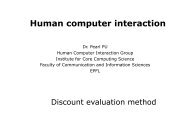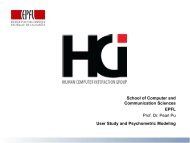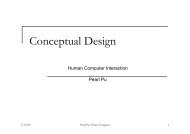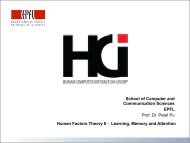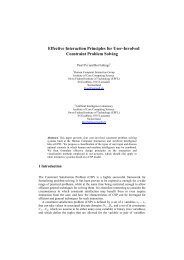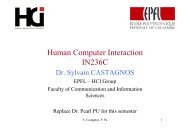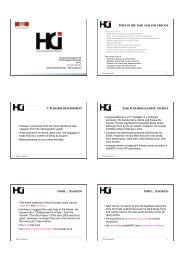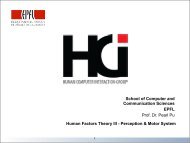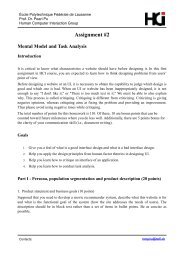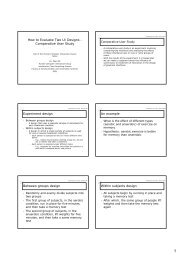Semiotics and Icon Design - HCI - EPFL
Semiotics and Icon Design - HCI - EPFL
Semiotics and Icon Design - HCI - EPFL
You also want an ePaper? Increase the reach of your titles
YUMPU automatically turns print PDFs into web optimized ePapers that Google loves.
<strong>Semiotics</strong> <strong>and</strong> <strong>Icon</strong> <strong>Design</strong><br />
Part of the Human Computer Interaction Course<br />
Notes<br />
Dr. Pearl PU<br />
Human Computer Interaction Group<br />
Institute for Core Computing Science<br />
Faculty of Communication <strong>and</strong> Information Sciences<br />
<strong>EPFL</strong>
human characteristics pearl pu <strong>EPFL</strong><br />
Semiotic<br />
• Definition<br />
• <strong>Semiotics</strong> is often called “the study (or theory) of<br />
signs.” It involves the study not only of what we<br />
refer to as 'signs' in everyday speech, but of<br />
anything which 'st<strong>and</strong>s for' something else<br />
(Ch<strong>and</strong>ler, sem01)<br />
• Peirce defines semiotics as a relationship among a<br />
sign, an object, <strong>and</strong> a meaning (Littlejohn 1999,<br />
p62)<br />
• <strong>Semiotics</strong> focuses on the ways producers<br />
create signs <strong>and</strong> the ways audiences<br />
underst<strong>and</strong> those signs (Littlejohn, p330)
human characteristics pearl pu <strong>EPFL</strong><br />
Metaphor <strong>and</strong> semiotics<br />
• Metaphors<br />
• Definition (The American Heritage<br />
Dictionary ): A figure of speech in which a<br />
word or phrase that ordinarily designates<br />
one thing is used to designate another,<br />
thus making an implicit comparison<br />
• In this way, the metaphor is itself a<br />
semiotic sign providing meaning<br />
obtained from what is referenced
human characteristics pearl pu <strong>EPFL</strong><br />
Three types of signs<br />
• <strong>Icon</strong>s are signs whose signifier bears a close resemblance<br />
to the thing they refer to.<br />
• According to Pierce, icons are "the only means of directly<br />
communicating an idea."<br />
• E.g. A road sign showing the silhouette of a car <strong>and</strong> a<br />
motorbike<br />
• Symbol shall mean what they mean <strong>and</strong> there is no<br />
natural relationship between them <strong>and</strong> their meanings<br />
• E.g. Most words are symbolic signs.<br />
• Index: In a sense, indexes lie between icons <strong>and</strong><br />
symbols. An index is a sign whose signifier we have<br />
learnt to associate with a particular signified.<br />
• E.g. smoke as an index of 'fire‘, a thermometer is an index<br />
of 'temperature'
human characteristics pearl pu <strong>EPFL</strong><br />
Example<br />
<strong>Icon</strong>ic cigarette<br />
Indexical bar (“You can’t do this”)<br />
Symbolic red circle on a white background<br />
(something is forbidden)<br />
The sign of “smoking forbidden”<br />
This kind of pictorial sign is also referred as icon in<br />
some cases.
Historical Trends for <strong>Icon</strong> <strong>Design</strong><br />
human characteristics pearl pu <strong>EPFL</strong><br />
• Four different levels of<br />
abstraction can be<br />
found over the last 80<br />
years (most recent on<br />
the right).<br />
• Actual icons get more<br />
abstract compared to<br />
the past.<br />
Adapted from Matthias Rauterberg
human characteristics pearl pu <strong>EPFL</strong><br />
An <strong>Icon</strong> Set for Different Sports<br />
Exercise:<br />
try to identify the<br />
different kinds of sports<br />
represented by each<br />
icon.<br />
Adapted from Matthias Rauterberg
human characteristics pearl pu <strong>EPFL</strong><br />
Redesign of <strong>Icon</strong>s (1)<br />
• <strong>Design</strong> Principle:<br />
• avoid excessive<br />
detail in icon<br />
design.<br />
• [see Deborah J. Mayhew, Principles <strong>and</strong><br />
Guidelines in Software User Interface<br />
<strong>Design</strong> (1992) pp.316-331]
human characteristics pearl pu <strong>EPFL</strong><br />
Redesign of <strong>Icon</strong>s (2)<br />
• <strong>Design</strong> Principles:<br />
• design the icons to<br />
communicate object<br />
relations <strong>and</strong><br />
attributes whenever<br />
possible;<br />
• accompany icons<br />
with names.<br />
• [see Deborah J. Mayhew, Principles<br />
<strong>and</strong> Guidelines in Software User<br />
Interface <strong>Design</strong> (1992) pp.316-331]
human characteristics pearl pu <strong>EPFL</strong><br />
Example: design effective icons<br />
• <strong>Design</strong> functionally suggestive icons<br />
• The best icon will suggest to the user the primary<br />
purpose of the program or operation without having to<br />
read accompanying text<br />
A functionally suggestive icon<br />
for word processor<br />
A functionally suggestive icon<br />
for underline
Procedure of icon design<br />
1. Draw the basic<br />
outline as close to<br />
48x48 pixels as<br />
possible<br />
2. Fill in with black<br />
<strong>and</strong> white to<br />
create detail
human characteristics pearl pu <strong>EPFL</strong><br />
Guidelines for designing the detail (1)<br />
• Analyze the verbal contents <strong>and</strong> the<br />
display environment<br />
• Determine how icon parts <strong>and</strong> complete icons<br />
should related<br />
• Too many parts may confuse the viewer<br />
• <strong>Design</strong> icons to differ in their "global"<br />
characteristics.
human characteristics pearl pu <strong>EPFL</strong><br />
Members of this set of icons<br />
differ considerably from the<br />
others in their "global"<br />
shapes
human characteristics pearl pu <strong>EPFL</strong><br />
Guidelines for designing the detail (2)<br />
• <strong>Design</strong> the initial icons by creating quick<br />
sketches<br />
• Not to be too precise or detailed early in the<br />
design process<br />
• More important to explore possible variations<br />
• Evaluate the designs by showing them to<br />
potential viewers<br />
• Which icons seem to meet the needs of the<br />
sender, the receiver, the message, <strong>and</strong> the<br />
medium
human characteristics pearl pu <strong>EPFL</strong><br />
Guidelines for designing the detail (3)<br />
• <strong>Design</strong> a layout grid that organizes<br />
all major elements of the icons<br />
• Use large objects, bold lines <strong>and</strong><br />
simple areas to distinguish icons<br />
• <strong>Icon</strong>s should be simple <strong>and</strong> clear
Procedure of icon design<br />
3. Add color <strong>and</strong><br />
anti-aliasing (less<br />
than five colors)<br />
4. Add gradients for<br />
a smooth,<br />
realistic effect,<br />
add a drop<br />
shadow<br />
Adapted from GNOME Usability Project icon design<br />
(http://developer.gnome.org/projects/gup/hig/2.0/index.html)
Procedure of icon design<br />
5. Do not include a text string naming the<br />
concept<br />
– Your images alone must be enough to<br />
convey the right associations<br />
– You may use up to one "iconic word"<br />
(such as "fax" or "loan")<br />
6. Each icon should be prepared as a<br />
separate .gif or .jpg file


